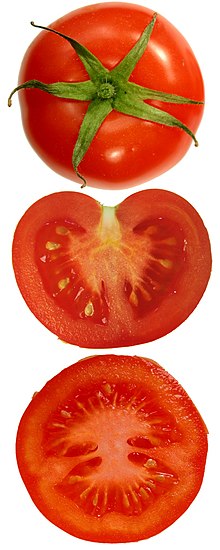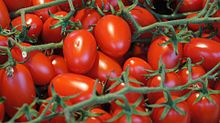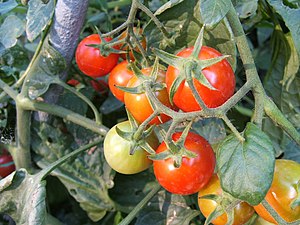Kamantoo
| Yaɣ sheli | fruit vegetable |
|---|---|
| Di bukaata | fruit vegetable |
| Yu'ŋmaa | помідор |
| Nangban yiŋga Yuya | Solanum lycopersicum |
| Yaɣili Kpamli | species |
| Lamba Zuliya | Solanum |
| Taxon synonym | Lycopersicon esculentum |
| Has fruit type | berry |
| This taxon is source of | Kamantoonsi, tomato juice |
| Pin' shɛŋa o ni dee | Vegetable of the year |
| Basionym of | Lycopersicon lycopersicum H.Karst. (1882) |
| Hardiness of plant | 2 |
| Taxon range | China, Tibet Autonomous Region, Guangdong |
| Taxon author citation | L. |
| GRIN URL | https://npgsweb.ars-grin.gov/gringlobal/taxonomydetail.aspx?id=101442 |
| Sequenced genome URL | https://plants.ensembl.org/Solanum_lycopersicum |
| Unicode bachinima | 🍅 |

Kamantooŋa (/təmeɪtoʊ/ bee /təmɑːtoʊ/) nyɛla binwɔlli din dira ka yina kamantoon gbuŋ ni (Solanum lycopersicum).[1][2] Di pili la western South America, Mexico, ni Central America.[2][3] Di ni tooi niŋ ka di zaŋ niŋ bindiri nyɛ din piliMexico polo.[2][4] Aztecs daa malila kamntoonsi duɣiri Spanish ni daa ŋme n-deei Aztec Empire saha shɛli, ka Spanish ni daa tuui nya kamantoonsi bɛ ni daa be Aztecs ni, ka bɛ daa dali kuli Europe, bɛ daa dalimi ni bɛ ni boli shɛli "Columbian exchange". Nimaani nyaaŋa, kamantoonsi daa gili Europe yaɣa 16th century.[2]
Kamantoonsi nyɛla din pahiri "umami" nyɔm.[5] Di dibu mali balibu pam: zaɣ'kahili bee di yi duɣi, ka niŋdi bindira pam ni, binnyura ni kpama ni. Kamantoon piɛla nyɛla binwɔla.[3]
Kamantooni balibu nyɛla bɛ ni kɔri shɛli dunia tiŋgbani yaɣa pam, ka di zuɣu che kamantoonsi binkɔŋdi yuuni puli ni. Kamantoongbuŋ zoori paari kamani 1–3 meters (3–10 ft) . Di gbuŋ ka yaa din ni tooi zani zuɣusaa ka di zuɣu che ka bɛ sari bɛ sari binyɛra din sɔdi li ka di zaana.[2] Kamaantooŋa ŋmelimbu dolila kamantooŋa balishɛli din nyɛli, ka di ŋmelindi paari kamani 1–10 cm (1⁄2–4 in) .[2]

Taaarihi
mali niŋKamantoonsi nyɛbila din nye, Solanum pimpinellifolium, chaŋ mi ti yina South America.[7] Lala kamantoon balli ŋɔ daa nyɛla din barilim mini paya saɣi.[7] Tuuli shɛhirili din wuhiri kamantoonsi zaŋ ku bukaata yiŋ nyɛla din tabi Aztecs nima mini ninvuɣu shɛb’ ban be "Mesoamerica", ban daa nye ban zaŋli duɣira. Spain niriba n-daa nye ban tooi zaŋ kamantoonsi wuhi Europe nima, din daa niŋ ka ban pun mali duɣiri bɛ bindira. France, Italy ni northern Europe, kamantoonsi daa na nyɛla bɛ ni sari shɛli nachiinsi zuɣu. Zlisiɣu daa na beni zaŋ chaŋ di bindiri tali polo ka dama botanists daa lihili ka di nyɛla “nightshade”, din tabi pɔizin tia, belladonna.[3] Ŋɔ daa nyɛla lahabali din ʒiɛ ka di nyɛla kamantoonsi puuni kom din nye acid la mini “pewter” yi gabi taba.[8] Di vari mini di wala nyɛla din mali “tomatine”, ka di yi galisi di ni tooi mali barina. Amaa, kamantoonsi din mooi dii ka “tomatine” ŋɔ pam n'ti paai din bi mooi.[9]
Mesoamerica
mali niŋDabsi chirichi bi mi zaŋ kpa di yiŋ kpɛbu na; 500 BC zaa, di daa pun nyɛla bɛ ni kɔri shɛli Mexico wulinluɣili polo ka yaɣa shɛŋa gba.[10]: Tɛmplet:R/where Pueblo niriba ban dihimi tabli ni ninvuɣu shɛba ban vaandi kamantoon bi nyɛla bam mali tim.[11] Kamantoonsi din mali pɔbri, din bala, ka nye zaɣi bihi, nyɛla ŋan yina Mesoamerica, ka di ni tooi nye din zuliya n-nye kamantoon shɛŋa din pa be biɛhigu ni ŋɔ.[10]: Tɛmplet:R/where
Aztecs nim ŋɔ daa nyɛla ban yihi kamantoon’ bali bɔbigu na, ka kamantoon ʒiɛ yuli nye xitomatl ka kamantoon vɔkahili yuli mi nye (physalis) called tomatl (tomatillo).[12] Bernardino de Sahagún wuhiya ni o daa nye kamantoon bali bɔbigu Aztec daa ni din be Tenochtitlán (Mexico City): “kamantoon kara, kamantoon bihi, vɔri kamantoonsi, kamantoon nyaɣasa, kamantoonsi din be ka bihili, kamantoon kara din be sapaɣa", ni kom kam kamantoonsi, zaɣa ʒiɛhi hali ni zaɣa dozima.[13] Bernardino de Sahagún yɛliya ni Aztecs duɣiri ka kamantoonsi kani bee ni kamantoon bali bɔbigu, ka kohirili tiŋ kara dahi ni: “bindira, binnyuri tula; bindiri chimda, lamalɛhi, ni kamantoonsi; tua duɣira, n'ti pahi kamantoon kpuli kara kom, din bi yaɣi laa kom, tuturi balibu balibu kom, paya kom."[14]
Spanish distribution
mali niŋSpain conquistador Hernán Cortés ni tooi nyɛ ŋun daa tuui zaŋ kamantoon dozim kpe Europe di ni daa niŋ ka o gbahi Aztec City Tenochtitlan, din pa nyɛ Mexico City, yuuni 1521. Piligu alizama zaŋ kpa kamantoonsi polo Europe litiricha ni nyɛla din daa yina herbal ni yuuni 1544 ka ŋun sabi li nyɛ Pietro Andrea Mattioli, Italy dɔɣite, ŋun daa wuhi ni “eggplant” bali shɛli nyɛla din kpe na ka di kom nyɛ zaɣi ʒee bee zaɣi dozim di yi mooi, ka ni tooi lahi ŋmahi kala kala n-ŋubi ka mani eggplant—di yi niŋ ka di duɣi ka niŋ yalim, naanzua, ni kpam niŋ. Yuun' pia nyaaŋa ka kamantoonsi yuli daa ti yina sabbu ni ka nyɛ Mattioli as pomi d'oro, bee "golden apples".[10]: Tɛmplet:R/where
Di ni daa niŋ ka Spain ŋmɛnfa America naai, Spain nim ŋɔ daa nyɛla ban tari kamantoonsi gili ban kam zaa bɛ sulinsi ni Caribbean. Bɛ daa lahi zaŋli chaŋ Philippines, ka di daa yi di ni kpe southeast Asia ka di kpe Asia bobli maa zaa. Spain nim ŋɔ n-daa lahi nye ban zaŋ kamantoonsi kpe Europe. Di zoobu daa bi tɔ Mediterranean ni, ka di kobu daa piligi yuuni 1540 saha. Bɛ daa pili di dibu di yibu na nyaaŋa, ka di daa nye bindirigu sɛnchiri pia ni apɔin saha, Spain.
China
mali niŋBan daa tuui zaŋ kamantoonsi wuhi China nim m-nyɛ Philippines bee Macau, yuma 1500 saha. Bɛ daa ti li yuli la 番茄 fānqié (foreign eggplant), ka di dumi tam bɛ China nim ni tooi tiri bindira din yina tiŋduya yuya shɛm, amaa ka lee zami ti kurum buna ha dina.[15]
Kɔbu
mali niŋKantooŋa nyɛla bɛ ni kɔri shɛli dunia zaa pirim la di wɔla ni dirila zuɣu, ka di mali balibu tuha.[16] Kulim din mali NPK ratio din nyɛ 5–10–10 n-tooi zooi ka bɛ kɔhirili kamantooŋa kulim,[citation needed] amaa kulimtam nyɛla bɛ ni lahi mali shɛli bahiri li.[citation needed]Kamantoon yini ni ʒi ni too paai kamani.[17]
Dɔriti
mali niŋ- LB – 'late blight'[18]
- V – verticillium wilt
- F – fusarium wilt strain I
- FF – fusarium wilt strain I and II
- N – nematodes
- T – tobacco mosaic virus, and
- A – alternaria.
Binnɛma
mali niŋKamantoonsi binnɛma ban niŋ bayana n-nyɛ tomato bug, stink bugs, cutworms, tomato hornworms ni tobacco hornworms, aphids, cabbage loopers, whiteflies, tomato fruitworms, flea beetles, red spider mite, slugs,[19] n-ti pahi Colorado potato beetles. Kamantoonsi "russet mite", Aculops lycopersici, dirila kamnatoonsi vari mini di wɔla, ka di che ka di vari gurinda, fulaawaasi ni wɔla ka ni tooi che kamantooŋa kpi.[20]
Binnɛma ŋɔ yi kpe kamantoonsi ni bɛ yɛligirimi.[21]
Other disorders
mali niŋHali di yi kuli pa dɔriti, kom yi bi saɣi kamantoonsi di zuɣu ni tɔoi che ka di mooi ka tɔhi lu.
Companion plants
mali niŋKamantoonsi mini binwɔla pamtabi taba.[22]
"Borage" nyɛla din kariti kamantoonsi binnɛma.[23]
Basil nyɛla binwɔlli din tabi kamantooŋa. Vihigu wuhiya ni di nyɛla din ni too kari binnɛma kamantoonsi ni. Amaa, di bi taɣiri kamantoonsi malisim di mini li yi ko m-miri taba.[24][25]
Kamnatoon gbuna ni tooi gu ka taɣi "asparagus" din yirina "asparagus beetles" ni, ka di daliri nyɛla di malila tim din kuri lala binnɛma ŋɔ,[citation needed] di mini "asparagus" gbuna mali "asparagusic acid" din kariti "nematodes" ban saɣindi kamantoon gbuna la.[26] "Marigolds" gba kariti "nematodes".[27][28][29]
Pollination
mali niŋFruit formation
mali niŋHydroponic and greenhouse cultivation
mali niŋPicking and ripening
mali niŋYield
mali niŋDunia nima daa zaŋ la yiika 4.8 miliyɔŋ n-ko kamantoonsi yuuni 2012 ka bɛ ni daa pɔhi kamantoon shɛŋa yiɣisi kpalansi 161.8 miliyɔŋ.[30] Yiika kam daa naan tooi niŋ paai kamani kpalansi 33.6 yiika kam zuɣuni yuuni 2012.[30]
Kamantoon puri din daa be Netherlands n-daa nyɛ din niŋ pam yuuni 2012, ka yiika kam ni tooi niŋ paai kamani yiika kɔbisinahi ni pisopɔin ni ayɔbu, Belgium n-daa do buyi zuɣu (ka yiika kam daa naan tooi niŋ kpalan kɔbiga ni pihiyɔbu ni ata) ka Iceland pahi buta (ka yiika kam daa naan tooi niŋ kamani kpalan kɔbisinahi ni pihita yini ka).[31]
Records
mali niŋZaŋ kana yuuni 2008, kamantoon timsili shɛli bɛ ni daa pɔhigi timsim daa yiɣisila 3.51 kg (7 lb 12 oz), kamantoon balishɛli din nyɛ "Delicious" n-daa nyɛli, ka ŋun daa ko li nyɛ Gordon Graham ŋun yina Edmond, Oklahoma yuuni 1986.[32][unreliable source?] Kamantoon gbuŋ din daa galisi daa nyɛla kamantoosi balishɛli din yuli nyɛ "Sungold" ka daa zooi paai 19.8 m (65 ft), ban daa ko li n-nyɛ Nutriculture Ltd (UK) din be Mawdesley, Lancashire, UK, yuuni 2000.[33]
Kamantoon gbuŋ din zoori pam Walt Disney World Resort "experimental greenhouses" din be Lake Buena Vista, Florida ni tooi nyɛ kamantoon gbuŋ din galisi dunia zaa. Kamantoon gbuŋ maa nyɛla "Guinness World Record Holder" ni mi shɛli yɛla, ka di niŋ kamantoonsi gari tuhi pihita ni ayi ni timsi din yiɣisi 522 kg (1,151 lb).[34] Di kamantoon gbuni yini kam nyɛla din niŋdi kamantoonsi tuhi bɔbigui. Yong Huang, Epcot kpɛma zaŋ ti pukparigu yaɣili, nyɛla ŋun nyɛ kamantoon gbuŋ din yi di ko Beijing, China. Huang ʒila di ʒi kuli Epcot n-ti bɔ soya ni di zooi ni. Lala kamantoon gbuŋ maa daa niŋla kamantoon kara, ka bɛ daa mali li niŋdi bindirigu ni "Walt Disney World restaurants" ni.[35] Dɔro daa gbaai lala kamantoon gbuŋ maa ka bɛ daa yiihili Anashaara goli April yuuni 2010 di ni daa niŋ chira pinaata nyaaŋa.[original research]
-
Tomato plants 7 days after planting
-
Tomato seedlings growing indoors
-
27 days after planting
-
52-day-old plant, first fruits
-
Tomatoes being collected from the field, Maharashtra, India
Storage
mali niŋKamantoo zaŋ zali viɛnyɛla nyɛla di yi na bi paɣi ka a zali room temperature ka bi che wuntaŋ kpɛri li. Di bi niŋ viɛnyɛla ni a zaŋ li niŋ firiiji puuni dama di pɔɣu maa bi kpɛma lala zuɣu di nyaɣisim nyɛla din yɛn booi.[36][37]
Di yi niŋ ka di duɣu maa do tiŋgbani ni tirisi di shelf life,[38] amaa ka leei che ka di pooi yomyom.[39]
Kamantoo din na bi mooi nyɛla binshɛli bɛ ni tooi mali niŋdi piɛɣu ni ka di mooi.[40]
Anfooninima
mali niŋ-
Various heirloom tomato (heritage tomato in British English) cultivars
-
Homegrown multicolored tomatoes
-
A variety of cultivars, including Brandywine (biggest red), Black Krim (lower left) and Green Zebra (top left)
-
Red tomatoes with PLU code in a supermarket
Kundivihira
mali niŋ- ↑ A chirim ya: Invalid
<ref>tag; no text was provided for refs namedNHM - ↑ 2.0 2.1 2.2 2.3 2.4 2.5 Garden Tomato. Solanum lycopersicum L.. Encyclopedia of Life.
- ↑ 3.0 3.1 3.2 Tomato. Encyclopaedia Britannica (4 January 2018).
- ↑ Tomato History.
- ↑ A chirim ya: Invalid
<ref>tag; no text was provided for refs namedfleming - ↑ Naden, Tony. 2014. Dagbani dictionary. Webonary.
- ↑ 7.0 7.1 Estabrook, Barry (22 July 2015). "Why Is This Wild, Pea-Sized Tomato So Important?". Smithsonian Journeys Quarterly. Retrieved 13 January 2020.
- ↑ Smith, K. Annabelle. Why the Tomato Was Feared in Europe for More Than 200 Years.
- ↑ A chirim ya: Invalid
<ref>tag; no text was provided for refs namedMcgee-NYT - ↑ 10.0 10.1 10.2 Smith, A. F. (1994). The Tomato in America: Early History, Culture, and Cookery. Columbia SC, US: University of South Carolina Press. ISBN 978-1-57003-000-0.
- ↑ Donnelly, L. (26 October 2008). "Killer Tomatoes". The East Hampton Star. http://www.easthamptonstar.com/dnn/Archive/Home20080814/FoodWine/Seasons/tabid/6280/Default.aspx.
- ↑ The Aztecs, Richard F. Townsend [Thames and Hudson:London], revised edition 2000 (p. 180-1)
- ↑ SILVERTOWN, J. (2017). Vegetables—Variety. DINNER WITH DARWIN: Food, drink, and evolution. S.l.: UNIV OF CHICAGO PRESS.(p. 145)
- ↑ Sophie D. Coe (2015). America's First Cuisines (page 117). University of Texas Press: Austin TX. pp. 108–118. ISBN 978-1477309711.
- ↑ Kiple, Kenneth F.; Ornelas, Kriemhild Coneè (2000). The Cambridge World History of Food. 1. Cambridge University Press. p. 357. ISBN 978-0-521-40214-9.
- ↑ Processing tomatoes. Commodity Fact Sheet. California Foundation for Agriculture in the Classroom (September 2014).
- ↑ Mortgage Lifter Tomato Seeds (en) (2021).
- ↑ Nowakowska, Marzena; et al. (3 October 2014), "Appraisal of artificial screening techniques of tomato to accurately reflect field performance of the late blight resistance", PLOS ONE, 9 (10): e109328, Bibcode:2014PLoSO...9j9328N, doi:10.1371/journal.pone.0109328, PMC 4184844, PMID 25279467
- ↑ Slugs in Home Gardens. University of Minnesota Extension (2009).
- ↑ Aculops lycopersici (tomato russet mite). Invasive Species Compendium, Centre for Agriculture and Biosciences International (23 June 2015).
- ↑ Narvaez-Vasquez, J.; Orozco-Cardenas, M. L. (2008). "15 Systemins and AtPeps: Defense-related Peptide Signals". In Schaller, A. (ed.). Induced Plant Resistance to Herbivory. ISBN 978-1-4020-8181-1.
- ↑ Tomato Casual » Boost Your Tomatoes with Companion Planting! – Part 1 Archived 1 Silimin gɔli September 2017 at the Wayback Machine. Tomatocasual.com (6 May 2008). Retrieved on 5 September 2013.
- ↑ Colleen Vanderlinden (29 June 2021). A Companion Planting Trio: Tomatoes, Borage, and Squash. The Spruce.
- ↑ Bomford, Michael (May 2009). "Do Tomatoes Love Basil but Hate Brussels Sprouts? Competition and Land-Use Efficiency of Popularly Recommended and Discouraged Crop Mixtures in Biointensive Agriculture Systems". Journal of Sustainable Agriculture 33 (4): 396–417. DOI:10.1080/10440040902835001.
- ↑ Bomford, Michael (May 2004), Yield, Pest Density, and Tomato Flavor Effects of Companion Planting in Garden-scale Studies Incorporating Tomato, Basil, and Brussels Sprout, West Virginia University Libraries
- ↑ (1975) "Identification of Asparagusic Acid As a Nematicide Occurring Naturally in the Roots of Asparagus". Chemistry Letters 4 (1): 43–4. DOI:10.1246/cl.1975.43.
- ↑ (2000) "Effects of amending soil with Tagetes patula cv. Single Gold on Meloidogyne incognita infestation of tomato". Nematology 2 (5): 489–93. DOI:10.1163/156854100509394.
- ↑ (2010) "Using marigold (Tagetes spp.) as a cover crop to protect crops from plant-parasitic nematodes". Applied Soil Ecology 46 (3): 307–20. DOI:10.1016/j.apsoil.2010.09.005.
- ↑ (2006) "Cold aqueous extracts of African marigold, Tagetes erecta for control tomato root knot nematode, Meloidogyne incognita". Crop Protection 25 (11): 1210–3. DOI:10.1016/j.cropro.2006.03.008.
- ↑ 30.0 30.1 FAOSTAT: Production-Crops, 2012 data. Food and Agriculture Organization of the United Nations (2014).
- ↑ "FAOSTAT: Production-Crops, 2012 data", Food and Agriculture Organization of the United Nations, August 2014
- ↑ "Curiosities of I-5, facts about King and the benefits of volunteers". Chester Progressive. 16 January 2008. https://news.google.com/newspapers?id=ej0-AAAAIBAJ&pg=1822,16289918&dq=heaviest+tomato+ever&hl=en.
- ↑ A World Record Breaker Archived 31 Silimin gɔli December 2020 at the Wayback Machine. Nutriculture.com. Retrieved on 5 September 2013.
- ↑ Most tomatoes harvested from one plant in one year (20 April 2006).
- ↑ The country's only single vine "tomato tree" growing in The Land pavilion at Epcot. Walt Disney World News
- ↑ Tomatoes:Safe Methods to Store, Preserve, and Enjoy. ANR Catalog. University of California: Division of Agriculture and Natural Resources (March 2004).
- ↑ Selecting, Storing and Serving Ohio Tomatoes, HYG-5532-93. Ohio State University.
- ↑ How To Cook. Cooks Illustrated (1 July 2008). Retrieved on 5 September 2013.
- ↑ Store Tomatoes Stem-End Down to Keep Them from Rotting Too Quickly. Lifehacker.com. Retrieved on 5 September 2013.
- ↑ Vegetables. Canadian Produce Marketing Association Website. Canadian Produce Marketing Association.
Further reading
mali niŋ- David Gentilcore. Pomodoro! A History of the Tomato in Italy (Columbia University Press, 2010), scholarly history
- (5 June 2012) "The Chemical Interactions Underlying Tomato Flavor Preferences". Current Biology 22 (11): 1035–1039. DOI:10.1016/j.cub.2012.04.016. PMID 22633806.
External links
mali niŋ| Wikibooks has a book on the topic of: Horticulture |
| Wikibooks has a book on the topic of: Tomato |
| Wikispecies has information related to Solanum lycopersicum. |
| Wikimedia Commons has media related to |
| Look up tomato in Wiktionary, the free dictionary. |
- Tomato Genome Sequencing Project – Sequencing of the twelve tomato chromosomes.
- Tomato core collection database – Phenotypes and images of 7,000 tomato cultivars
